Sylvania LED Lamps GU10 Dimmable




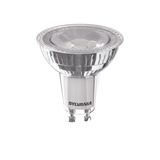

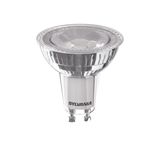
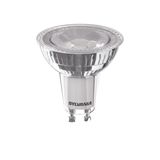
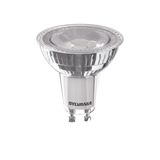
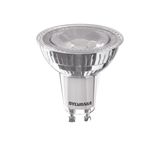

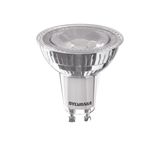
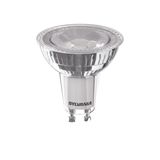
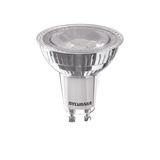
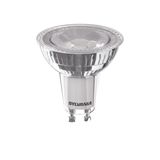

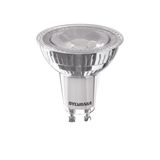


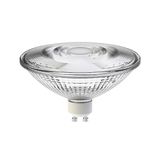
sylvania gu10 dimmable led lamps range and project context
Compact mains spots that dim cleanly without rewiring are still the quickest way to stabilise ceilings. Drivers are tuned for 220–240 V AC, PF typically ≥0.9, THD ≤15%, and declared inrush for Type B/C MCB sizing. Output bands ~250–700 lm cover corridor, task, and accent layers with 24°/36°/60° beams. CRI 80 is standard; CRI 90 SKUs hold colour on timber and textiles. CCT 2700/3000/4000 K ship in ≤3-step SDCM so phases read the same. Installers select sylvania gu10 dimmable led lamps when they need predictable fade curves and calm restart after brief outages.
sylvania gu10 dimmable bulbs photometrics and flicker behaviour
Low-level stability matters more than headline lumens. With validated trailing-edge dimmers, Pst LM < 1.0 and SVM < 0.9 are achievable at maintained scenes; ripple is kept inside office guidance. Thermal stacks are rear-biased so trims stay cool. In camera-heavy rooms, projects specify sylvania gu10 dimmable bulbs to avoid shimmer at 10–20% egress levels and to keep colour uniform across adjacent bays.
sylvania adjustable gu10 spotlights optics and aiming
Accent work needs beam discipline and cut-off. Deep reflectors and low-luminance apertures control high-angle brightness; 24° for punch, 36° for tables, 60° for general fill. Tilt mechanisms must preserve the photometric centre when adjusted. Designers pair fittings with sylvania adjustable gu10 spotlights so aisle and display hotspots repeat floor to floor without chasing bespoke optics.
sylvania dimmable led spot lamps electrical and thermal notes
Caps follow IEC 60061 geometry; holders should be checked for spring force and heat ageing. Operating window −20…+50 °C (model dependent); surge typically 1–2 kV L-N. Drivers publish inrush to protect shared feeders. For enclosed cans, confirm ambient and pick short-neck bodies. Maintenance teams record sylvania dimmable led spot lamps against approved dimmers and minimum-load thresholds to stop nuisance buzz or dropout.
sylvania recessed dimmable lighting ceiling integration
Shallow plasterboard boxes and retrofit fire hoods limit depth. Keep clearance around heat paths, ensure bezel overlap hides cut edges, and verify UGR targets where spots operate near VDT zones. Emergency circuits must sit upstream of dimming. On mixed estates, designers standardise sylvania recessed dimmable lighting by beam, lumen band, and trim colour so spares move between rooms without visual drift.
sylvania gu10 retrofit dimmable leds controls and interfaces
Where scene engines already run DALI-2 or 1–10 V, sockets can remain at fixed mains and scenes are set upstream on contactor-fed circuits. For legacy phase packs, use the validated matrix and publish minimum loads by circuit. Projects that document sylvania gu10 retrofit dimmable leds keep commissioning fast while preserving analytics on the control backbone.
sylvania indoor dimmable spot bulbs applications and spacing
Corridors run corridor function with 10–20% standby; classrooms and offices combine 36° beams with neutral whites; hospitality prefers warm CRI 90 on 24° accents to lift vertical illuminance on surfaces. Spacing depends on mounting height and wall reflectance—hold ~30% beam overlap to avoid scalloping. Schedulers mark sylvania indoor dimmable spot bulbs by room type so crews don’t mix optics within a bay.
Technical specifications and standards for engineers
- Electrical: 220–240 V AC; PF ≥0.9 typical; THD ≤15%; declared inrush; surge 1–2 kV L-N.
- Photometric: 24°/36°/60° beams; ~250–700 lm; efficacy ~95–125 lm/W; CRI 80/90; CCT 2700/3000/4000 K; ≤3 SDCM.
- Thermal/operating: −20…+50 °C; rear-biased heat paths; short-neck options for shallow cans.
- Flicker: target Pst LM < 1.0 and SVM < 0.9 on validated dimmers.
- Compliance: IEC/EN 62560 self-ballasted, EN 61347 controlgear safety, EN 55015 emissions, EN 61000-3-2 harmonics, EN 62471 photobiological.
Applications and compatibility
- Offices/education: neutral whites, low-glare trims, scene recall upstream; document dimmer lists.
- Retail: tight 24° accents with CRI 90; maintain beam family per aisle to keep visual rhythm.
- Hospitality/housing: warm 2700–3000 K, calm egress levels, short-neck lamps in enclosed domes.
Always inspect lampholders, replace brittle collars, and keep earth continuity in metal trims.
Integration with other Sylvania categories
Match CCT/CRI with Sylvania panels and linear luminaires so thresholds don’t show colour seams. Tie presence/daylight logic to Sylvania automatics and control; keep emergency testing upstream of dimming. Where recessed kits or fire hoods are needed, align with Sylvania accessories to preserve IP and sight lines.
Selection criteria for B2B clients
- Fix target lux and vertical illuminance by zone; choose beam first, then lumen class.
- Lock CCT/CRI and ≤3 SDCM across phases.
- Decide control path: validated trailing-edge vs upstream DALI-2/1–10 V.
- Record inrush, PF at dim, and surge per SKU against feeder MCB curves.
- Verify can depth, trim colour, and fire-hood compatibility; label circuits with the approved dimmer matrix.
Advantages of working with Bankoflamps
We price by room bundle and show live EU stock before crews are scheduled. Quotes land in about an hour with EAN/MPN so variants stay fixed. Your portal provides lead times, shipment status, and downloadable price lists with planning-grade validity. Approved accounts can use post-payment up to 30 days. We consolidate partials to cut freight, and your account manager checks beam set, dimmer type, inrush/surge data, trim colour, fire-hood fit, and emergency routing against your drawings so cartons arrive site-ready across France, the Baltics, Germany, Spain, Italy, Belgium, and the Netherlands.